
6.7 Powerstroke Daily Driver vs. Workhorse: Which One is Right for You?
The 6.7 Powerstroke has been a solid platform for Ford, for the most part. However, sometimes catastrophic engine failures necessitate a replacement. At Choate Engineering
The 6.0L Ford Powerstroke Engine has been around since the late 2003’s. And Choate Engineering Performance has been working on them shortly since they came out of warrany. It came about because of a change in emissions from the EPA. The 7.3L Ford Powerstroke was known and loved by many since 1994.5. Now it was on its way out. This engine was the staple of the F-250-F550 Ford pickup truck line. It truly was the only engine that deserved to stand against the Cummins 5.9L Dodge Ram engine that was introduced in 89′. But the glory days of the old diesels were making their way out and many changes were coming for the new emission standards. The 6.0L Powerstroke Engine was going to be going head to head with the new kid on the block that was showing promise, GM Duramax 6.6L Diesel Engine and the all new fuel design of the 5.9L Cummins Diesel common rail system. Ford is normally the first on the market in the diesel engine platform. Whether you are a Ford fan or not, that’s the truth.
The 6.0 l Powerstroke Diesel Engine was going to get a major upgrade in driveability and performance! This all new turbocharger would change drastically from the GTP38 to the GT3782VA. This would bring with it the variable vane turbocharger or variable geometry turbo aka VGT or VNT. This would allow spooling time to decrease and acceleration to increase. Also, this would make the signature “whistle” the 6.0L is know for and that would be a fan favorite.
With it however, would bring some problems that hadn’t been experienced before. Head Gasket failure of the 6.0 would be synonomous with the engine and become a black eye for Ford. Costing them millions in warranty, and even more in vehicle sales. This would also be such a devistating blow that was so unrecoverable to Ford that it would end a relationship between Ford and International that had started back decades before! They would now battle out in litigations the money spent in warranties. This was the beginning of the end, that door wouldn’t completely close until 2011. At that point Ford would go on to make their own 6.7L Ford Powerstroke Diesel Engine in house.
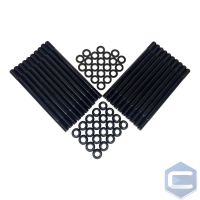
-
Add to cart
-
Select options This product has multiple variants. The options may be chosen on the product page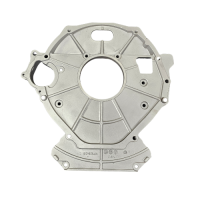
-
Read more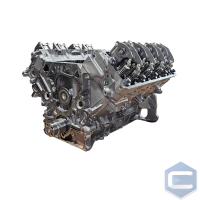
-
Select options This product has multiple variants. The options may be chosen on the product pageA sad day indeed it was, when such a dynamic duo between Ford Motor Company and International Navistar would part ways. You have to ask, what caused this? What were the failures? And no doubt, if you own a 6.0 Powerstroke or you are looking for a 6.0 Powerstroke Crate Engine, you want to know. And you deserve to know, so you can educate yourself as to how to keep this disaster from affecting your wallet and your life.
Where should I begin? Because this truly was a perfect storm, and domino effect that would continue to topple each failure after it.
We just spoke about turbochargers previously, and we gave you the good. But now, lets give you the rest of the story. Here is the bad. And to understand it, you need to understand a little about how the turbo works.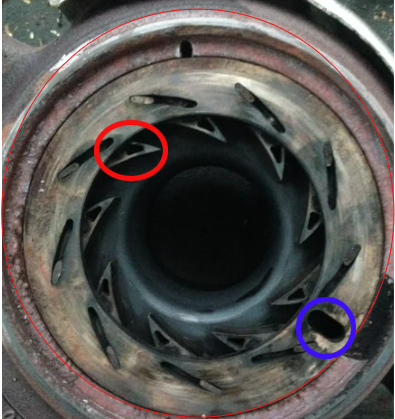 The VGT was like most things in engineering when it is first designed. It looks great on paper but the rest of the story isn’t told until you find out what you didn’t know. That is a major reason why Choate Engineering Performance has a big advantage over the OEM engineers. We get to see the failures after they have had hundreds of thousands of miles on them. The idea was great, and it truly worked well. But two things were the downfall of it. One, they didn’t know about the EGR cooler that would be so prone to failure in the updated version of the 2004 square cooler. This would cause coolant to gum the vanes of the turbocharger and stick.
The VGT was like most things in engineering when it is first designed. It looks great on paper but the rest of the story isn’t told until you find out what you didn’t know. That is a major reason why Choate Engineering Performance has a big advantage over the OEM engineers. We get to see the failures after they have had hundreds of thousands of miles on them. The idea was great, and it truly worked well. But two things were the downfall of it. One, they didn’t know about the EGR cooler that would be so prone to failure in the updated version of the 2004 square cooler. This would cause coolant to gum the vanes of the turbocharger and stick.
We are already seeing the snowball get bigger. Once the vanes would stick, it would cause overboost conditions and excessive drive pressures against the piston. This means that the extra cylinder pressure has to go somewhere. And it will find the fuse in the system. But, we will get to that later…….
Secondly, the issue was the way the turbo was controlled. It is told by the ECM how much boost to build. The problem is that somewhere in this whole thing there has to be a physical signal that is turned into a digital one. Meaning, the pressure in the exhaust has to be told to the ECM so it can make the necessary changes.
When driving off from a stop light, the turbo needs to change its geometry so that the housing is actually smaller than what it is. This increases the pressure inside the turbine housing. From the increased pressure, it will in turn through the combined gas law, cause an increase in velocity of the air vectored over the turbine wheel. Which will cause the compressor wheel to spin faster, increasing the boost of the engine.
That all sounds lovely. But there is one issue. Exhaust turns to soot and soot is a wonderful tool to plug orifices. And the sensor is about .200 of an inch in diameter. If the exhaust backpressure sensor gets plugged it will cause the ECM to not receive the change in pressure. In other words, it doesn’t see any effect the turbo is making when it is boosting, and continues to ask for more boost. Which means, the head gasket and rods are forced to endure more punishment. And this is all because soot is stopping up the sensor.
If you are experiencing “turbo bark” and sluggish response, you should look at the EBP sensor. This little issue can cause you very expensive repairs if left unattended. Like a blown headgasket, hence the need to use Head studs.
Ok, maybe it doesn’t actually stand for that, but it should. Because that’s exactly what it does. We briefly spoke about the EGR or exhaust gas recirculation cooler failures. The 03′ used a round cooler that seemed to be very reliable. But for whatever reason, the choice was made to switch to the most unreliable cooler known to man. But we can’t blame it all on the cooler. There is more on that later….
The important thing to know is that when the failure of the cooler occured, it dumped coolant on top of the piston through the intake manifold. Greeeaaattt…… Because what we really need is more cylinder pressure on a 18:1 Compression ratio piston. (Insert sarcasm now)… Seriously, the worst thing that could happen just did. And we will get into the rest of the story shortly. At any rate, coolant isn’t compressible and we are forcing it to do just that. It’s known as “hydro-locking” an engine hydro meaning fluid, and locking coming from the Latin word, meaning “oh crap!”

-
Add to cart
-
Add to cart
-
Select options This product has multiple variants. The options may be chosen on the product page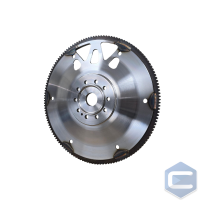
-
Add to cartSo the real question is why did the EGR pop? That’s a great question, glad you asked! That would be because there wasn’t enough coolant going through the cooler. As you can tell by now, the good ol 6.0 Engine seems to be a bit of a proverbial dumpster fire doesn’t it? Well, have no fear Choate Engineering Performance is here. We will talk about the fixes as soon as we finish making smores.
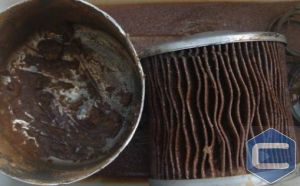 The reason why the egr cooler was starved for coolant was because the oil cooler was stopped up. I know, you are asking yourself….”well how in the world did the 6.0L Powerstroke Oil Cooler get stopped up?!” Welp, that’s because there was sand and sediment left in the block from the casting process. This is the reason why we highly suggest the use of a 6.0L Coolant Filter when you own a 6.0L. . Here is a link for that kit. If you look in the photo you can see just how nasty the coolant of the 6.0L Ford Engine is.
The reason why the egr cooler was starved for coolant was because the oil cooler was stopped up. I know, you are asking yourself….”well how in the world did the 6.0L Powerstroke Oil Cooler get stopped up?!” Welp, that’s because there was sand and sediment left in the block from the casting process. This is the reason why we highly suggest the use of a 6.0L Coolant Filter when you own a 6.0L. . Here is a link for that kit. If you look in the photo you can see just how nasty the coolant of the 6.0L Ford Engine is.
And, it only gets worse with unknowing owners replace the leaking coolant with tap water. Then, we have rust forming through the process of oxidation. And once you start forming rust, it can get so bad that it errodes the deck of the block as well as everything it touches. All of this cast iron and rust gets redeposited into the oil cooler. And the “high oil temps” concern will plague the engine and owner indefinitely. There are some cleaners that help a lot with this. Like VC-9 cleaner, you can find it here on this link.
It is common practice since the days of the Flathead Ford, that 6 head bolts were used for each cylinder. A diesel engine has a much higher cylinder pressure than that of gasoline. This is the fundamentals of compression ignition. If we are using heat to ignite the engine, we need to compress the oxygen inside the cylinder to a higher pressure, and in turn a higher temperature. So if an engine were to need a better fastner, or larger surface area around a nut, or more fastners, it would be a diesel engine.
I can’t explain why the engineers thought that this was a good idea. I can only assume someone in their department lost a bet. Or they got a bonus for using less bolts. And so the decision was made to reduce the head bolts to 4 instead of 6 per cylinder. This would be a fuse that would blow again and again. Perhaps the engineers thought because they were going to a multi layer steel gasket, or MLS, that it would work. I don’t know. But I do know that if I was looking for a remanufactured engine and the engine supplier offered head bolts on a 6.0L along with an “upgraded head stud package” I would find another engine supplier. Clearly they don’t understand the inner working of the engine or they aren’t interested in making an engine that would last.
All 6.0L Engines at Choate Engineering Performance Remanufactured Engines come standard with head studs. Our motto is “stock is not an option” and if there is a failure ,we are going to address it. Even on our Model C 6.0L Ford Powerstroke Engines, they come standard with them. And all other engine models as well in long block and full runner/complete engine formats are outfitted with a 230k lb high tensile strength stud.
The additional pressure in the cylinder head will cause the head to lift from the block. When this occurs there isn’t enough clamp force to hold the head down, it destroys the head gasket. This in turn pressurizes the coolant system and you will notice coolant pushing out of the coolant reservoir.
A lot of people have replaced the cap thinking that it was not holding pressure. It’s a cheap fix if it is, and if you have a pressure tester you can test it without buying one.
I might use this time to add, that if your are looking at buying a new 6.0L Ford longblock, or remanufactured complete 6.0L Powerstroke Engine. That it would be to your credit to verify that the engine manufacturer is surfacing the deck. Head Studs will not correct an uneven surface. And you will find yourself on the side of the road sending up coolant smoke signals to the ford engineers. If you are unfamiliar with the phenomenon of wringing, then watch this link. You would be amazed at how many “professional engine builders” do not surface the blocks. This is most likely because they don’t have the equipment large enough to do a diesel engine. I would NOT recommended choosing this for my 6.0L Ford remanufactured engine or any other engine honestly. And a lot of times they won’t sell a short block because you will see it. So they prefer to sell you a long block reman engine so that they can cover the ugly surface of the deck. Stay clear, you have been warned.
There is alot more to know about choosing the right engine. One of which is the use of “spray weld” technology. We show a bit about this in the “Why you don’t want a Ford reman engine” on our page. Be sure to check out this link for that.
There is more to talk about with the 6.0L Ford Powerstroke Engine platform, but Cass covered most of it in the video included in this article. We wanted to focus on the failures of just the long block. And why they failed, how you can keep them from failing, and what to look for when you are looking for a replacement remanufactured 6.0L Ford powerstroke engine. If you would be interested in us doing a deeper dive into the other failures outside of the engine, please drop a comment and let us know. We appreciate your reading and interest in our page.
If you have questions about your 6.0L Ford Powerstroke or another diesel engine, feel free to contact us or leave them below. Thanks guys!

The 6.7 Powerstroke has been a solid platform for Ford, for the most part. However, sometimes catastrophic engine failures necessitate a replacement. At Choate Engineering

https://youtu.be/GLBoU2AmWJs It’s highly likely if you have a 7.3L and are looking for answers to some of your issues you may be searching words like
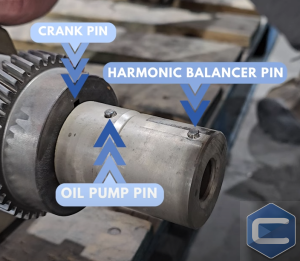
The Duramax Crankshaft Failures. And How to Avoid Them. Lets talk about your problems….. The 6.6 Duramax Diesel Engine has been a fantastic platform since